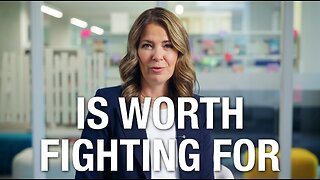Premium Only Content

Paul Krugman on Inflation
Rumble = https://rumble.com/user/SweetHomeStAugustine
Locals = https://sweethomesa.locals.com/
POPULIST REVOLT = https://populistrevolt.com
https://www.msn.com/en-us/money/markets/paul-krugman-how-high-inflation-will-come-down/ar-AAVz9Kx
Rising prices will get worse before they get better. Russia’s invasion of Ukraine has caused the prices of oil, wheat and other commodities to soar. Official measures of the cost of shelter don’t yet fully reflect last year’s surge in the cost of newly rented apartments. So there’s still a lot of inflation in the pipeline.
The Federal Reserve, however, believes that high inflation will be a temporary phenomenon. Furthermore, the Fed believes that it can bring inflation down relatively painlessly — that it can achieve a so-called soft landing.
But doesn’t this fly in the face of history? After all, the last time America had to bring high inflation under control, during the 1980s, the cost was immense. The unemployment rate soared to 10.8% and didn’t get back to 1979 levels until 1987. Are there good reasons to believe that this time is different?
Actually, there are. The landing probably won’t be as soft as the Fed envisions, but this time disinflation shouldn’t, or at least needn’t, be an extremely painful process.
To see why, we need to look at history more closely and appreciate the important differences between the last big inflation and our current situation.
Forty years ago, as many economists will tell you, inflation was “entrenched” in the economy. That is, businesses, workers and consumers were making decisions based on the belief that high inflation would continue for many years to come.
One way to see this entrenchment is to look at the wage contracts — typically for three years — that unions were negotiating with employers. Even then, most workers weren’t unionized, but these deals are a useful indicator of what was probably happening to wage- and price-setting more generally.
So what did those wage deals look like? In 1979, union settlements with large companies that didn’t include a cost-of-living adjustment specified an average wage increase of 10.2% in the first year and an annual average of 8.2% over the life of the contract. As late as 1981, the United Mine Workers negotiated a contract that would raise wages 11% annually over the next several years.
Why were workers demanding, and employers willing to grant, such big pay hikes? Because everyone expected high inflation to persist for a long time. In 1980, the Blue Chip survey of professional forecasters predicted 8% annual inflation over the next decade. Consumers surveyed by the University of Michigan expected prices to rise by about 9% annually over the next five to 10 years.
With everyone expecting inflation to continue, workers wanted raises that would keep up with rising prices, and employers were willing to grant those raises because they expected their competitors’ costs to be rising as fast as their own. What this did, in turn, was make inflation self-perpetuating: Everyone was raising prices in anticipation of everyone else raising prices.
Ending this cycle required a huge shock — an economy so depressed both that inflation fell and that workers were compelled to accept major concessions.
Things are very different now. Back then almost everyone expected persistent high inflation; now few people do. Bond markets expect inflation eventually to return to prepandemic levels. While consumers expect high inflation over the next year, their longer-term expectations remain “anchored” at fairly moderate levels. Professional forecasters expect inflation to moderate next year.
This means that we almost surely aren’t experiencing the kind of self-perpetuating inflation that was so hard to end in the 1980s. A lot of recent inflation will subside when oil and food prices stop rising, when the prices of used cars, which rose 41% (!) over the past year during the shortage of new cars, come down, and so on. The big surge in rents also appears to be largely behind us, although the slowdown won’t show up in official numbers for a while. So it probably won’t be necessary to put the economy through an ’80s-style wringer to get inflation down.
That said, the Fed is probably too optimistic in believing that we can get inflation under control without any rise in unemployment. Statistical measures like the unprecedented number of unfilled job openings, anecdotal evidence of labor shortages and, yes, wage increases suggest that the job market is running unsustainably hot. Cooling that market off will probably require accepting an uptick in the unemployment rate, although not a full-on recession.
-
 6:53
6:53
Rena Malik, M.D.
23 hours ago $0.29 earnedWhy Antidepressants Wreak Havoc on Your Sex Life?! | Urologist Explains How to Boost your Libido
4.53K3 -
 1:00:00
1:00:00
BEK TV
2 days agoMIKE MOTSCHENBACHER ON NORTH DAKOTA POLITICS, TEA PARTY ROOTS, AND THE 2026 ELECTION
5.68K -
 15:31
15:31
Breaking Points
1 day agoIs Trump Planning VENEZUELA Regime Change?
27.6K15 -
 2:06:05
2:06:05
"What Is Money?" Show
2 days agoTrump Family Bitcoin Bet Will Trigger Nation-State FOMO w/ Matt Prusak (CEO American Bitcoin)
9.34K -
 1:04:36
1:04:36
Dialogue works
3 days ago $3.66 earnedMohammad Marandi: Iran Just Gave Israel a FINAL Warning…
16.3K6 -
 9:20
9:20
daniellesmithab
1 day ago3 Bad Laws
18.9K7 -
 9:22
9:22
MattMorseTV
18 hours ago $11.18 earnedINDIA just made a BIG MISTAKE.
62K57 -
 12:11
12:11
Nikko Ortiz
17 hours agoCrashout 6 Rumble
15.5K3 -
 22:35
22:35
GritsGG
17 hours agoThe KILO is BACK! The Best AR on Warzone FRIES!
24K1 -
 2:16:36
2:16:36
Side Scrollers Podcast
20 hours agoStreamer KICKED OUT of Renaissance Fair for Misgendering + Spiderman MELTDOWN | Side Scrollers Live
46.1K8